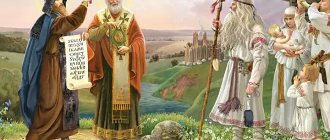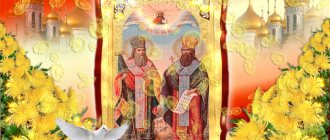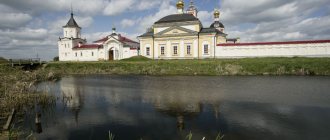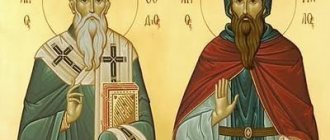- Reports
- People
- Cyril and Methodius
Cyril and Methodius are well-known personalities throughout the world; they earned their fame thanks to the Slavic alphabet they created, which became the basis for all future writing in the Russian lands. The brothers were Byzantines by origin, coming from the upper class, they could easily aspire to good positions, including courtiers of the imperial court, but since childhood they were very interested in church life, and this is the path they chose for themselves. The brothers received an excellent education and were very smart and quick-witted. By the way, the names Cyril and Methodius are church names, real data and at birth they are Constantine and Michael.
In addition to church affairs, one cannot help but note Methodius’s affinity for military affairs; at one time he even held the high post of commander-in-chief. But Kirill, on the contrary, liked teaching more; it’s not for nothing that he was called “philosopher” behind his back.
The history of the creation of the alphabet goes back to the 9th century, when the prince of Moravia unexpectedly turned to Byzantium for help; he really needed educated people who could enlighten his people. The Emperor, without thinking twice, asked Kirill to take up this issue. He was immediately transported to Moravia, the philosopher took his students and his beloved brother as his assistants. By the way, it was Cyril who tried the most, Methodius also helped, but he was not the initiator of the events; rather, he tried at the request of his brother. At first, their work consisted of translating books, only then did the idea of creating an alphabet appear. The creation of the alphabet took a significant amount of time, namely a year. Since the contribution of one brother was still greater, they did not think about the name for a long time, it became known as Cyrillic. After this, Cyril and Methodius were engaged in educational activities in foreign lands for another three long years.
The invented alphabet consisted of twenty-four letter symbols, and in the end there were much more sounds, so the brothers had to borrow a couple of letters from other alphabets, and they came up with a few themselves. Therefore, the final version already consisted of thirty-eight letters. Each letter had its own sound designation; these sounds helped to understand what it was ultimately about. A little later, the number of letters decreased slightly.
The further fate of the brothers was tragic; Cyril fell ill at the end of the 9th century and died some time later. Methodius continued his brother's work, but was soon arrested and imprisoned in a monastery. And not much time later he died the same way. But the names of these people are not forgotten and are still revered.
Report on the topic: Cyril and Methodius
Cyril and Methodius.
Cyril (in the world Constantine; 827-869) and Methodius (in the world Michael; 815-885), brothers from the city of Thessaloniki - educators of the Slavs, creators of the Slavic alphabet, preachers of Christianity.
Canonized and revered as saints in both the East and the West.
Cyril and Methodius came from the Byzantine city of Thessaloniki. Their father was a drungari under the military commander of the city. There were seven sons in the family, with Methodius the eldest and Cyril the youngest.
According to one version, they came from a pious Slavic family who lived in the Byzantine city of Thessaloniki. From a large number of historical sources, mainly from the “Short Life of Clement of Ohrid”, it is known that Cyril and Methodius were Bulgarians.
According to another version, Cyril and Methodius were of Greek origin.
There is an alternative theory of the ethnic origin of Cyril and Methodius, according to which they were not Slavs, but Bulgars (proto-Bulgarians). This theory also refers to the assumptions of historians that the brothers created the Glagolitic alphabet, an alphabet more similar to the ancient Bulgarian than to the Slavic.
The brothers were natives of the city of Thessaloniki, which at that time was part of the Slavic territory and was the cultural center of Macedonia. Ancient Thessaloniki was a bilingual city, in which, in addition to the Greek language, a Slavic dialect was heard.
Before becoming a monk, Michael made a good military-administrative career, culminating in the post of strategos of Slavinia, a province located in Macedonia.
Konstantin was a very educated person for his time. Even before his trip to Moravia, he compiled the Slavic alphabet and began to translate the Gospel into the Slavic language.
Scientists have not come to a consensus about the role of Cyril and Methodius in the spread of Christianity in the Bulgarian Khanate. Skeptics believe that the brothers, during the baptism of Khan Boris, were carrying out a Moravian mission and could not participate in this event. At the same time, Bulgarian researchers have a different opinion.
The sister of the Bulgarian Khan Boris was held hostage in Constantinople. She was baptized with the name Theodora and was raised in the spirit of the holy faith. Around 860, she returned to Bulgaria and began to persuade her brother to accept Christianity. Boris was baptized, taking the name Mikhail. Saints Cyril and Methodius were in this country and with their preaching they greatly contributed to the establishment of Christianity in it. From Bulgaria, the Christian faith spread to its neighboring Serbia. In 863, with the help of brother Methodius and his disciples, he compiled the Old Slavonic alphabet and translated the main liturgical books into Bulgarian from Greek.
The time of the invention of the Slavic alphabet is evidenced by the legend of the Bulgarian monk Chernorizets Khrabra, a contemporary of Tsar Simeon, “On Writings”.
Thus, the creation of the Slavic alphabet can be dated back to 863 after the Nativity of Christ.
In 862, ambassadors from the Moravian prince Rostislav came to Constantinople with the following request: “Our people profess the Christian faith, but we do not have teachers who could explain the faith to us in our native language. Send us such teachers.” The emperor and patriarch rejoiced and, calling the holy Thessalonica brothers, invited them to go to the Moravians.
In Moravia, Cyril and Methodius continued to translate church books from Greek into the Slavic language, teaching the Slavs to read, write and conduct worship in the Slavic language. The brothers stayed in Moravia for more than three years, and then went with their disciples to Rome to the Pope. Among some theologians of the Western Church, there is a point of view that praise to God can only be given in three “sacred” languages: Hebrew, Greek and Latin. Therefore, Cyril and Methodius, who preached Christianity in Moravia, were perceived as heretics and summoned to Rome. After Cyril handed over to Pope Adrian II the relics of St. Clement he had found on his Chersonesos journey, he approved the service in the Slavic language, and ordered the translated books to be placed in Roman churches. Methodius was ordained to the rank of bishop.
In Rome, Constantine fell seriously ill, at the beginning of February 869 he finally fell ill, took the schema and the new monastic name Cyril, and died 50 days later (February 14). He was buried in Rome in the Church of St. Clement.
Since 870, the activities of Methodius and his disciples took place in very difficult conditions. The Latin-German clergy in every way prevented the spread of the Slavic language as the language of the church.
In 879, the German bishops organized a new trial against Methodius. However, Methodius brilliantly justified himself in Rome and even received a papal bull allowing worship in the Slavic language.
In 881, Methodius, at the invitation of Emperor Basil I of Macedon, came to Constantinople. There he spent three years, after which he and his students returned to Moravia. With the help of three students, he translated the Old Testament and patristic books into Slavic.
In 885, Methodius became seriously ill. Before his death, he appointed his student Gorazd as his successor. On April 19, Palm Sunday, he asked to be taken to church, where he read a sermon. On the same day he died. The funeral service for Methodius took place in three languages - Slavic, Greek and Latin.
Cyril and Methodius were born into a wealthy and noble family in the city of Thessaloniki (Greece). Methodius was the eldest brother in the family and was the ruler of the Bulgarian principality, which at that time was part of the Byzantine Empire. Kirill (born Konstantin) is the younger brother who demonstrated high mental abilities from infancy. While still at Thessaloniki school, he began reading the books of the Church Fathers. Gregory the Theologian made a special impression on young Constantine. The gifted young man was noticed, and he was invited to Constantinople, where he studied along with the emperor’s son from the best scientists of his time. Among Constantine's teachers was the famous scientist Photius, the future Patriarch of Constantinople. A brilliant career at the imperial court awaited Constantine, but he chose a monastery cell. After completing his studies, he retired to a monastery on Mount Olympus to Methodius to “continually pray and engage in pious meditation,” as his biography says. However, Constantine's seclusion was rarely long. As a preacher and propagandist, he was often sent to neighboring states to participate in disputes. Travel weakened Constantine's strength. In 42 he became very ill. Before his death, he became a monk with the name Cyril and died in 869. Death overtook Cyril in Rome, where the brothers sought the Pope's support in spreading Slavic writing. The biography tells that before his death, Cyril said to his brother: “You and I, like two oxen, drove the same furrow. I am exhausted, but don’t think about leaving the work of teaching and retiring to your mountain again.” Methodius outlived his brother by 16 years. He translated the Holy Books into Slavic, preached the Orthodox faith, and baptized the Slavic people. He trained about two hundred Slavic priests. “The Tale of Bygone Years” tells about the beginning of writing in Rus': one day the Slavic princes Rostislav, Svyatopolk and Kotsel sent ambassadors to the Byzantine Tsar Michael with the words: “Our land is baptized, but we have no teacher who would instruct and teach us, and explained the holy books. After all, we do not know either Greek or Latin; Some teach us this way, and others teach us differently, so we don’t know either the shape of the letters or their meaning. And send us teachers who could tell us about book words and their meaning.” Then Tsar Michael summoned two learned brothers - Constantine and Methodius, and “the king persuaded them and sent them to the Slavic land... When these brothers arrived, they began to compile the Slavic alphabet and translated the Apostle and the Gospel.” These events date back to 863. The spread of writing in Rus' is associated with this date. The Slavic alphabet also appeared. In Kyiv, Novgorod, and other cities, schools began to be created to teach Slavic literacy. An alphabet appeared, which was called “Cyrillic” after the monastic name of Constantine. It was composed based on Greek, but modified to convey a Slavic sound system. Two alphabets were created - Glagolitic and Cyrillic. Cyril and Methodius also managed to overcome the prejudice that only Hebrew, Greek and Latin were suitable for worship and writing church books. After the brothers presented the new alphabet, the Pope approved worship in the Slavic language, and ordered the books translated by the brothers to be placed in Roman churches and the liturgy to be performed in the Slavic language. In Russia, the holiday has been celebrated since 1863. In modern Russia, the Days of Remembrance of Saints Cyril and Methodius and the Days of Slavic Literature and Culture have been celebrated since 1985.
About the benefits of education
If you study well, you can achieve a lot. No, this is not an advertisement for the Unified State Exam from the Ministry of Education, but clear examples, facts from the biography of the brothers Cyril and Methodius, who before taking monastic orders were called Michael and Constantine, confirming this simple truth. But first things first:
- The brothers were born into a wealthy family in Thessaloniki, which was part of the Byzantine Empire. The city was inhabited by Greeks and Slavs.
- The father, named Leo, served in a high position, either as a strategist (governor and commander in one person) of Thessaloniki, who had full administrative and military power, or as his deputy, which is also not bad.
- About the mother, who, given her husband’s position, and taking into account the traditions and morals of that time, apparently was a housewife, all that is known is that her name was Maria.
- The brothers' grandfather was a nobleman at the court of the ruler of the Byzantine Empire.
- The children ate well, were not denied anything, their parents and grandfather tried to give them the most brilliant education, the results of which, as well as family upbringing, the example of life, the father’s career, were not long in coming.
- At the age of twenty, Michael (for ease of understanding, hereinafter referred to as Methodius) occupies a position in the military-administrative structure of the Byzantine Empire, equivalent to his father’s, and devotes himself to service for ten years, having made a successful career. This continued until the decision was made to resign and accept the schema and become abbot of the Polychron monastery.
- Konstantin (Kirill) was younger than his brother. Interesting facts from his biography directly indicate that he was a child prodigy and a polyglot. He studied with the emperor's son from the best teachers, scientists of Constantinople. One of them was Photius, who later became the patriarch - the head of the church of the Byzantine Empire.
- Knowledge of languages, rhetoric, and general knowledge allowed him to become the keeper of the library at the Church of Hagia Sophia, then a teacher of philosophy at the Constantinople School - the highest and most prestigious educational institution of the vast empire. For his intelligence, faith, and oratory, which allowed him to defeat any opponents in numerous disputes, his contemporaries nicknamed him Constantine the Philosopher.
Conclusion: good family upbringing, excellent education and, without a doubt, successful genetic data, their own talents allowed the brothers to make careers in completely different fields. It is unlikely that the world would remember them if they took higher positions in the Byzantine Empire. No matter how trite, but only outstanding deeds and actions of people leave a long memory of them. The Solun brothers were able to do this.
Konstantin or Kirill
Constantine, younger in age, but not in intelligence, being one of the most educated people of his time, understood both secular sciences and complex theological issues. Among his teachers was Photius, who later became the Patriarch of Constantinople. Having rejected the prospects of a brilliant career at the court of the Byzantine emperor, Constantine the Philosopher spent his entire life bringing the light of the Orthodox faith to different peoples. Being an excellent polemicist, he repeatedly won victories in theological disputes among non-believers. Only 50 days before his death, Konstantin, together with his schema, took the name Cyril, under which he entered world history. The alphabet created by the brothers was called “Cyrillic” in honor of St. Cyril.
Kirill taught philosophy
Kirill studied with the best teachers in philosophy, geometry, arithmetic, and astronomy. Then, after completing his studies, he got married. After which he was ordained a reader and sent to serve in the Cathedral of St. Sophia in Constantinople.
But one day he neglected his position and decided to leave the monastery. He lived in solitude for a long time. Subsequently, he was forcibly returned to the city and assigned to teach philosophy at the university, where he himself had once studied . It was there that he received the nickname Constantine the Philosopher. It is worth noting that Kirill led many people to the Christian faith.
Creation of the Slavic alphabet
Heeding the request of the Prince of Moravia, who was looking for learned men who would tell his people “about book words and their meaning,” the enlightenment brothers, together with their students, began to create the Slavic alphabet and translate the sacred books necessary for worship into the Slavic language. The word of Christ, spoken in their native language, fell as a living seed into people’s hearts, and the people converted to the Orthodox faith. It is known from the chronicles that the first words they wrote in the letters of the new alphabet were the opening lines of the Gospel of John: “In the beginning was the Word, and the Word was to God, and God was the Word.” This event, which became the cornerstone for the further development of society, occurred in 863.
Thessalonica brothers
In biographies testifying to the missionary and educational works of Saints Cyril and Methodius, the future creators of the Slavic alphabet are often called Thessaloniki brothers. It is known that they were really siblings of Greek origin from the city of Thessaloniki or Thessaloniki, in Macedonia. The elder Methodius (in the world Michael) interrupts his successful military career, takes monastic vows and plunges into spiritual life, spending time in prayer and reading holy books. The younger Konstantin (in schema Cyril), being an unusually gifted youth, strove for knowledge from an early age. For his inquisitive mind, Constantine was often called the Philosopher.
Cyrillic alphabet
There are different assumptions about the original form of the first Slavic alphabet. Various mystical and secret meanings and different levels of perception are attributed to it. With a greater degree of probability, it can be argued that the Greek alphabet became the basis for the creation of a new writing system. Of the 43 letter signs, 24 were similar to Greek, and 19, through complex phonetic comparisons with Slavic speech, appeared for the first time under the pen of the Solun brothers.
Have the Solun brothers ever visited Rus'?
The missionary asceticism of Saints Cyril and Methodius obliged the Thessaloniki brothers to visit different countries, among different peoples. But the chroniclers are silent that the enlighteners ever visited the lands of Ancient Rus'. But they entered the territory of modern Russia. Carrying out a mission to Khazaria, Cyril and Methodius reached the lands where the Volgograd and Rostov regions are located today, and ancient Korsun, where the brothers also had to visit, is located on the Crimean Peninsula.
Since childhood, Kirill has been interested in literature and other sciences
The brothers were born into a fairly rich and noble family. The father was a famous military man. There have been many speculations about the origins of these two brothers.
According to one of the most common versions, they had Greek roots. But scientists in the 19th century defended their Slavic origins, based on the fact that they had an excellent command of the Slavic language. But the Bulgarians believe that they belonged to the Bulgarian family.
But it is worth noting that the city of Thessaloniki, in which they lived, was considered a bilingual city. When an analysis of the translation language of the brothers was carried out, it showed that they spoke Slavic as their native language.
But after both brothers received their education, their paths in life diverged, but not for long. Since childhood, Kirill was interested in literature and other sciences, and was a very gifted person . Even after his death, information remained that repeatedly emphasized the depth and breadth of his knowledge.
Constantine later became a professor at the capital's University of Constantinople. The first task he received was to defend the truth of Christianity before other people of other faiths.
The end of earthly labors
After numerous intrigues of enemies, slander, and false accusations, Constantine’s poor health was completely undermined and, having taken monastic vows, Cyril died at the age of 42 . He bequeathed his brother Methodius and his disciples not to abandon work on the Holy Scriptures, which was fulfilled. By order of the Pope, the body of St. Cyril was buried in Rome in the Cathedral of St. Clement.
Methodius, together with his faithful disciples, was able to finish transcribing the remaining texts of the Old Testament into Slavic writing. He spent the last days of his life in Moravia, outliving his brother by a little more than 16 years. Burial place of St. Methodius is unknown.





